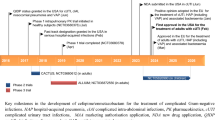Summary
The antibiotic policy in 34 Dutch formularies for the treatment of urinary tract infections (UTI) was evaluated. A great variation in antibiotic therapy for the treatment of cystitis was observed: the length of therapy ranged from 1 to 14 days, the agents recommended included older compounds such as trimethoprim-sulfamethoxazole and newer agents such as ciprofloxacin. Recommendations for the treatment of acute pyelonephritis were: a 2 week course of co-trimoxazole in 20 out of 34 formularies. Likewise for acute prostatitis less variation was observed for the length of treatment, i.e. 2 weeks co-trimoxazole, doxycycline or quinolones.
Zusammenfassung
Die übliche Antibiotikaanwendung wurde bei 34 Verordnungsweisen in holländischen Krankenhäusern bei Harnwegsinfektionen ermittelt. Dabei fand sich eine große Variationsbreite der Anwendungen von Antibiotika bei Zystitis mit Therapiedauer von 1–14 Tagen und Verwendung älterer Präparate wie Trimethoprim-Sulfamethoxazol und neueren wie Ciprofloxacin. Bei der akuten Pyelonephritis wurde bei 20 von 34 Verordnungen eine 2wöchige Co-Trimoxazolbehandlung empfohlen. Auch bei akuter Prostatitis wurde relativ einheitlich eine Therapiedauer von 2 Wochen mit Co-trimoxazol, Doxycyclin oder Chinolonen empfohlen.
Similar content being viewed by others
References
Stobberingh, E. E., Janknegt, R., Wijnands, W. J. A. Antibiotic guidelines and antibiotic utilisation in Dutch hospitals. J. Antimicrob. Chemother. 32 (1993) 153–161.
Stamm, W. E., Hooton, Th. M. Management of urinary tract infections in adults. N. Engl. J. Med. 329 (1993) 1328–1334.
Fihn, S. D., Johnson, C., Roberts, P. L., Running, K., Stamm, W. E. Trimethoprim-sulfamethoxazole for acute dysuria in women: a single-dose or 10-day course. Ann. Intern. Med. 108 (1988) 350–357.
Hooton, Th. M., Running, K., Stamm, W. E. Single-dose therapy for cystitis in women. A comparison of trimethoprim-sulfamethoxazole, amoxicillin, and cyclacillin. JAMA 253 (1985) 387–390.
Tolkoff-Rubin, N. E., Wilson, M. E., Zuromskis, P., Jacoby, I., Martin, R. M., Rubin, R. H. Single-dose amoxicillin therapy of acute uncomplicated urinary tract infections in women. Antimicrob. Agents Chemother. 25 (1984) 626–629.
Iravani, A., Tice, A., McCarty, J., Sikes, D., Nolen, T., Gallis, H., Whalen, E., Tosiello, R., Heyd, A., Kowalsky, S., Echols, R. forthe Urinary Tract Infection Study Group Short-course ciprofloxacin treatment of acute uncomplicated urinary tract infection in women. The minimum effective dose. Arch. Intern. Med. 155 (1995) 485–494.
Saginur, R., Nicolle, L. E. andthe Canadian Infectious Disease Society, Clinical Trials Study Group Single-dose compared with 3-day norfloxacin treatment of uncomplicated urinary tract infection in women. Arch. Intern. Med. 152 (1992) 1233–1237.
Bailey, R. R. Review of published studies on single dose therapy of urinary tract infection. Infection 18 (1990) 53–56.
Fihn, S. D., Stamm, W. E. Interpretation and comparison of treatment studies for uncomplicated urinary tract infections in women. Rev. Infect. Dis. 7 (1985) 468–478.
Norrby, S. R. Short-term treatment of uncomplicated lower urinary tract infections in women. Rev. Infect. Dis. 12 (1990) 458–467.
Rubin, R. H., Shapiro, E. D., Andriole, V. T., Davis, R. J., Stamm, W. E. General guidelines for the evaluation of new anti-infective drugs for the treatment of urinary tract infection. Evaluation of new anti-infective drugs for the treatment of urinary tract infection. Clin. Infect. Dis. 15 (1992) (Suppl. 1) S216-S227.
Trienekens, T. A. M., Stobberingh, E. E., Winkens, R. A. G., Houben, A. W. Different lengths of treatment with co-trimoxazole for acute uncomplicated urinary tract infections in women. Br. Med. J. 299 (1989) 1319–1322.
Brumfitt, W., Hamilton-Miller, J. M. T. Therapeutic update. Prophylactic antibiotics for recurrent urinary tract infections. J. Antimicrob. Chemother. 25 (1990) 505–512.
Inter-Nordic Urinary Tract Infection Study Group Double-blind comparison of 3-day versus 7-day treatment with norfloxacin in symptomatic urinary tract infections. Scand. J. Infect. Dis. 20 (1988) 619–624.
Hoiby, N. Ciprofloxacin in urinary tract infections. Scand. J. Infect. Dis. 60 (1989) (Suppl. 60) 54–57.
Carratalá, J., Fernández-Sevilla, A., Tubeau, F., Callis, M., Gudiol, F. Emergence of quinolone-resistantEscherichia coli bacteremia in neutropenic patients with cancer who have received prophylactic norfloxacin. Clin. Infect. Dis. 20 (1995) 557–560.
Andriole, V. T., Patterson, T. F. Epidemiology, natural history, and management of urinary tract infections in pregnancy. Med. Clin. North Am. 75 (1991) 359–373.
Boscia, J. A., Abrutyn, E., Kaye, D. Asymptomatic bacteriuria in elderly persons: treat or do not treat? Ann. Intern. Med. 106 (1987) 764–766.
Hooton, T. M., Winter, C., Tiu, F., Stamm, W. E. Randomized comparative trial and cost analysis of 3-day antimicrobial regimens for treatment of acute cystitis in women. JAMA 273 (1995) 41–45.
Finch, R. G.: Adverse reactions to antibiotics. In:Greenwood, D. (ed.): Antimicrobial chemotherapy, Oxford University Press 1995, pp. 206–218.
Neeling, A. J. de, de Jong, J., Overbeek, B. P., de Bruin, R. W., Dessens-Kroon, M., van Klingeren, B.: Kwantitatief gevoeligheids-on-derzoek met intra- en extramurale isolaten vanEscherichia coli. Rapport nr. 359001002. National Institute of Public Health and Environmental Protection (RIVM) (1990).
Trienekens, T., Stobberingh, E., Beckers, F., Knottnerus, A. The antibiotic susceptibility patterns of uropathogens isolated from general practice patients in southern Netherlands. Antimicrob. Chemother. 33 (1994) 1064–1066.
Naber, K. G. Use of quinolones in urinary tract infections and prostatitis. Reviews of Infectious Diseases Suppl. 5 (1989) S1321-S1337.
Centraal Begeleidingsorgaan voor de Intercollegiale Toetsing (CBO): Het syndroom van de acute pijnlijke frequente mictie en de patiënt met een langdurige verblijfscatheter. Utrecht 1988.
Nederlands Huisartsen Genootschap (NHG) Standaard urineweg-infecties. Huisarts en Wetenschap 32 (1989) 527–530.
Author information
Authors and Affiliations
Rights and permissions
About this article
Cite this article
Stobberingh, E., Janknegt, R. & Wijnands, W.J.A. Treatment of urinary tract infections in Dutch hospitals. Infection 24, 234–237 (1996). https://doi.org/10.1007/BF01781099
Received:
Accepted:
Issue Date:
DOI: https://doi.org/10.1007/BF01781099




